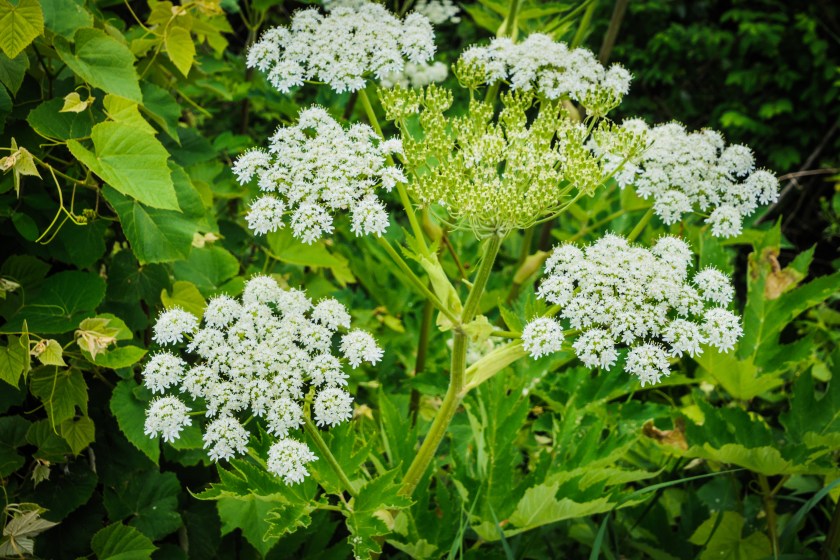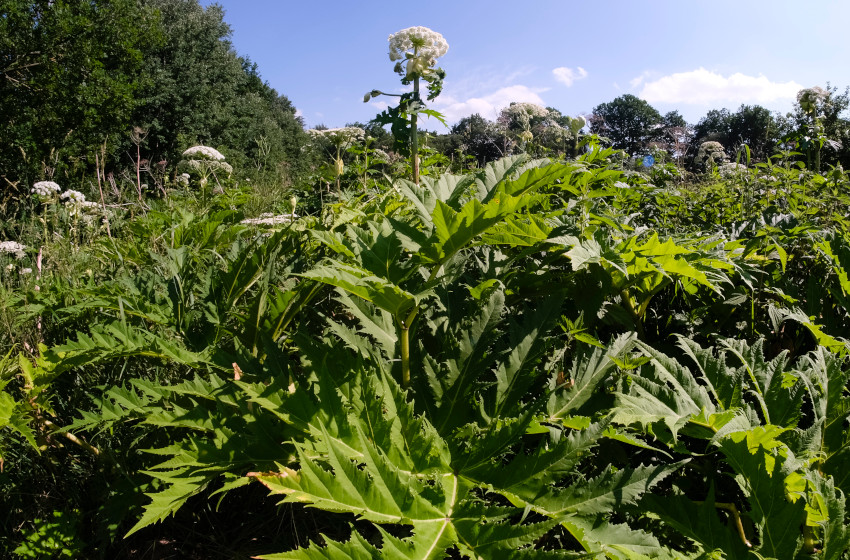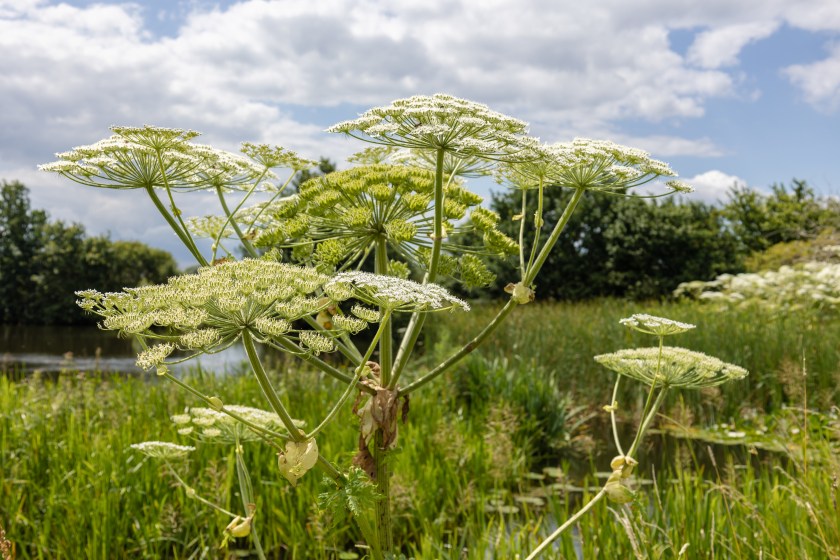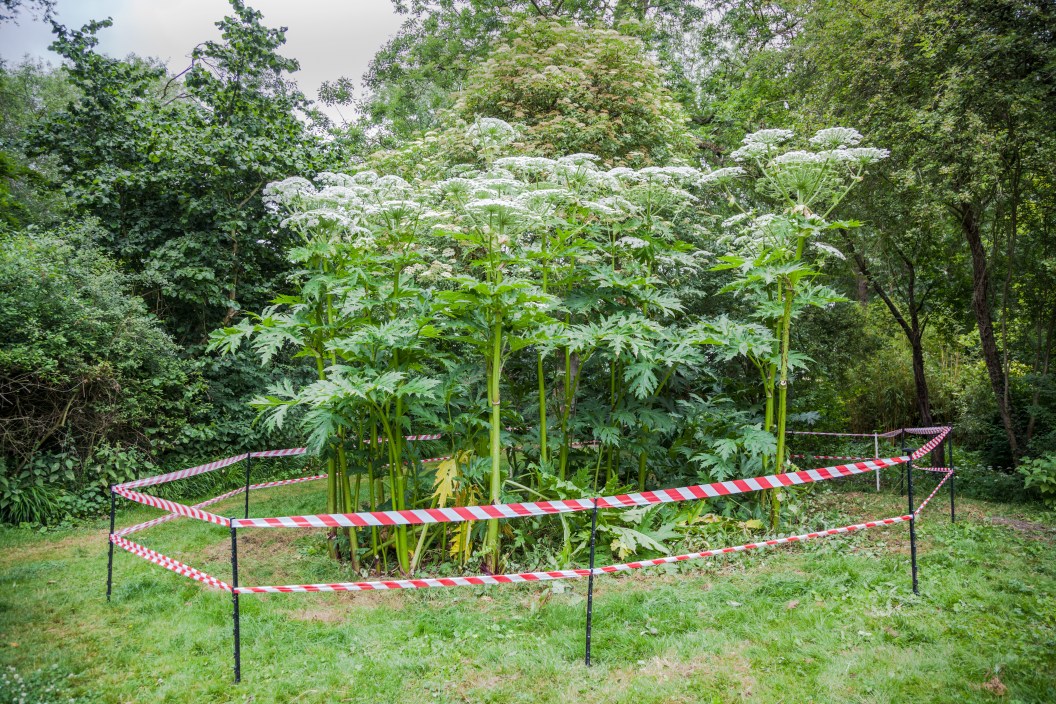Among the myriad diverse native plants in North America, there's a thriving population of invasive species. While most people think of invasive animals like the feral hog or Asian carp, there are plenty of troublesome invasive plants, too.
One particular noxious weed stands out from the crowd, as it presents a danger to humans, especially small children. It's the giant hogweed plant or Heracleum mantegazzianum, as it is known in scientific circles.
What Is Giant Hogweed?

Getty Images, KenWiedemann
Native to the Caucasus Mountains in Eurasia, this plant with innocent-looking white flowers has been reported in over a dozen in recent years, including Pennsylvania, Maine, and Washington. Its tall leafy stalks with a blooming white flower head make the giant hogweed stunning to look at—and according to the Michigan Department of Agriculture & Rural Development (another state all too familiar with the weed), it was introduced stateside as an ornamental plant.
However it happened, one thing is clear: The giant hogweed's toxic sap presents a health hazard, causing skin burns or even blindness. If you think this is scary stuff, you're not alone. The good news is that it's not super common (yet) and it's easy to spot.
Here's what you need to know about this plant species, and what you should do if you discover an infestation of it in your yard or encounter it during your outdoor adventures.
Why You Should Never Touch Giant Hogweed
Giant hogweed is a dangerous plant because the sap is phototoxic for humans. This means that once it gets on the skin, it can react to sunlight, causing severe burning and blistering in an inflammatory reaction known as phytophotodermatitis. This is very similar to handling the sap of wild parsnip.
How the reaction works gets rather technical. It involves the cells in your skin and how they react to ultraviolet light from the sun's rays. All you really need to understand is that people exposed to giant hogweed sap often experience nasty blisters, burning, and scarring.
What Happens If You Touch Hogweed?
Reactions to the sap can happen as quickly as to 15 to 20 minutes after first contact, but it can take longer; the length of time the reaction lasts varies from person to person. For some people, their reaction may only last a few hours. Others may suffer ill effects for days afterward. Worst-case scenarios may require a trip to the emergency room.
In 2018, 17-year-old Alex Childress had a giant hogweed plant fall on his face while working a summer landscaping job. He ended up spending two days in intensive care after the incident.
"I thought I just had a sunburn, so I didn't really pay attention," Childress told People. "Then I got in the shower, and I started rubbing my face. I thought it was just a little bit of skin at first, but then big chunks of my face were falling off."
In addition to the scarring and blistering, the sap can also cause dark brown discoloration on the skin. In some recorded cases, areas of the skin exposed to giant hogweed can remain sensitive to sunlight years later, even after the scars have fully healed.
Sap is present in just about all parts of the plant. Most people come in contact after unknowingly grabbing or cutting the hollow stem.
If you accidentally come into contact with this plant, experts recommend washing the affected area with soap and water as soon as possible. You should also keep the affected area out of sunlight. It's not a bad idea to seek the advice of your doctor, especially if discomfort persists longer than a few hours.
What Does Giant Hogweed Look Like?

Getty Images, picture alliance
Giant hogweed is part of the umbel (apiaceae) family shared with celery, carrot, and parsley. It shares a similar appearance to its cousins, with compound leaves and tall stalks crowned by small white flower clusters. Fortunately, the size of this plant is what usually gives it away. In perfect conditions, the adult specimens can grow up to 14 feet tall or more. Giant hogweed flower clusters may be as large as two to three feet across.
The stalk is green but is usually marked with red or dark reddish-purple blotches. Keep an eye on the bristles, which appear as coarse white hairs on the stem. These hairs contain the poisonous sap. Below the flowers are a series of large jagged and lobed leaves. Just like the rest of the plant, the leaves are huge and can reach up to four to five feet across themselves.
Giant hogweed identification can be a bit tricky because there are a few lookalikes out there. The two most common ones you might encounter are wild carrots, also known as Queen Anne's lace, and cow parsnip. The latter can also cause burning, albeit not as severe. To tell them apart, look at the crown of flowers for a clue. The New York Department of Environmental Conservation (DEC) notes hogweed flowers are "umbrella-shaped," while cow parsnip's similar white flowers are "flat-topped." Queen Anne's lace has fern-like stems and flower clusters that are much smaller, only a few inches across.
Poison hemlock is also sometimes mistaken for giant hogweed. However, its flowers are also flat-topped and the leaves closely resemble a fern. Experts say if you want to be better safe than sorry, it's best to just avoid any tall plant with white flowers.
What Is the Difference Between the Giant Hogweed and Common Hogweed?
As the names might suggest, the most obvious difference between the giant hogweed and common hogweed is its size. Another important distinction is that common hogweed is not harmful to humans. In fact, it's edible when cooked and gives an herbal flavor to dishes.
You can tell the two plants apart by their appearance. The common variety has more rounded leaves, while the giant hogweed has pointed, almost spiked leaves. Take a look at the stem: Giant hogweed has purplish blotches while common hogweed is usually solid green with a slight purple hue in some cases. The flowering season is much longer for the common hogweed, from May to August, while the giant hogweed usually blooms only in June and July.
Where Does Giant Hogweed Usually Grow?

Getty Images, Henk Hulshof
According to data from the University of Georgia, giant hogweed has been positively identified in 14 states: New York, New Jersey, Connecticut, Massachusetts, Vermont, Maine, North Carolina, Michigan, Indiana, Illinois, Wisconsin, Washington, Oregon, and Alaska. There have also been reports in two Canadian Provinces: Prince Edward Island, and Ontario, which is the brunt of the confirmed Canadian instances of the plant.
New York seems to be ground zero for the plant here in the United States. According to the state's DEC, only a handful of NY counties have zero confirmed giant hogweed reports. Most of the sites confirmed by authorities seem concentrated in the northwestern part of the state near the Buffalo and Rochester regions.
As for ecosystems where you're most likely to encounter it, near rivers and streams are common. The DEC reports giant hogweed prefer moist soil conditions and areas that gets a lot of sunlight. However, it's an adaptable plant that will grow in partial shade. Another common place they pop up is along roadsides and backyard edges.
What to Do if You Find Giant Hogweed
The USDA officially classifies the giant hogweed as a federal noxious weed. This means that state and federal agencies closely monitor reports of this plant and will often take drastic steps to manage it. For instance, New York has a dedicated hogweed control program. The DEC will send a crew to your property free of charge to help remove it if you give them a call. It's probably a better idea to call in the experts than try and remove it yourself, mostly because removing it requires protective glasses and clothing to keep the sap off your skin.
The DEC usually deals with giant hogweed infestations by using herbicide, although it should be noted that some agencies prefer to dig up the root structure too. Another good reason to call the experts is because they will know the best management practices to avoid the weed spreading any further. This plant produces up to 20,000 seeds, and the experts know how to mitigate these being spread and making the problem worse.
All in all, giant hogweed might not be a very common thing to encounter, but you'll want to practice extra caution if you ever come across it.




